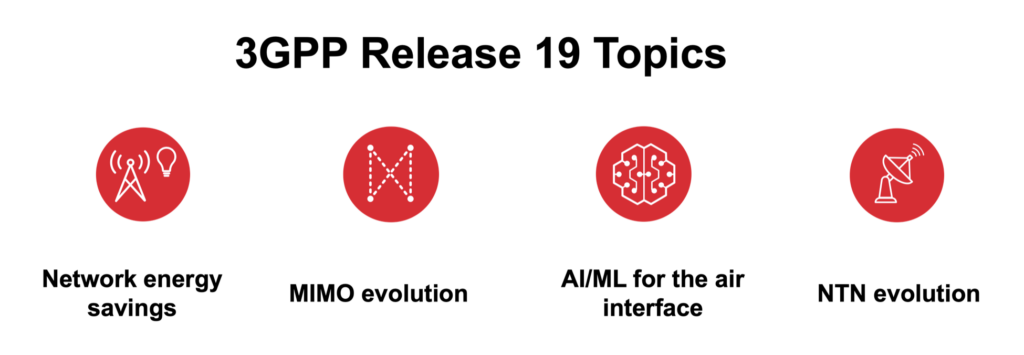As future 6G standards are discussed this year, current work on Releases 18 and 19 in areas such as AI / ML, MIMO, and power savings will provide the starting point.
The rollout of 5G is well underway. At the same time as 5G is being installed and deployed to the masses, the 3rd Generation Partnership Project (3GPP) organization is working on developing standards for 5G Advanced. The topics included in the latest 3GPP give an indication of what may be included in the first release of 6G.

As engineers, starting work on 6G and a new set of challenges is exciting, but as an industry we still have a lot of work to do on 5G and 5G Advanced. Articles and presentations at recent wireless industry events have been quick to criticize the roll out of 5G and lackluster reception from consumers. In reality, many consumers have only experienced the non-standalone (NSA) version of 5G. The most exciting and promising features of 5G need standalone (SA) to be deployed to be realized, which isn’t widely available outside of India and China today.
The next several years of 5G Advanced development and deployment will give communications engineers an opportunity to reinvigorate consumers and the larger wireless ecosystem by delivering much anticipated features and upgrades to networks. Research and development into the foundations for 6G will happen in parallel. The timeline in Figure 1 shows where we are today in relation to 3GPP releases and the International Telecommunication Union – Radiocommunication Sector (ITU-R) timeline to approve a first version of the 6G standard.

In 2023, the major focus for 2023 was completing work and finalizing Release 18, which is the first official release supporting 5G Advanced. According to Wanshi Chen, chairman of the 3GPP Radio Access Network (RAN) plenary, Release 18 aims to drive a balanced 5G evolution across key technology areas, while also taking into consideration the ways 5G Advanced will evolve in Release 18, Release 19, and beyond. This evolutionary approach led to many study items (SIs) being defined and set up as work items in later releases.
Major topics covered in Release 18 include MIMO enhancements, in particular for uplink and mobility scenarios, NR-Light (RedCap) evolution, evolved duplexing, and AI/ML data-driven designs. The MIMO enhancement uplink improvement aims to improve the user experience when trying to upload content in crowded locations, a common pain point for customers. And RedCap looks to provide a low-power solution for devices like sensors and wearables.
In parallel to the work being done in Release 18, the first plenary meeting was held in June 2023 to discuss the package of projects that will be included in Release 19. This package was refined and approved at the December 2023 RAN plenary (RAN #102) with a target timeframe of 18 months for the duration of Release 19. The primary focus of Release 19 will be 5G-Advanced, and again this release will be all about balance.
When deciding what is included, the 3GPP chairman is looking to strike a balance between short-term fixes and long-term feature development, mobile broadband evolution versus the expansion of vertical use cases, and device evolution versus network evolution. Release 19 is important because it will also serve as a bridge to 6G. Release 20 is anticipated to be the first official release to include 6G study items, but there is strong interest in initiating some studies sooner for important topics like channel modeling for 7-24 GHz and integrated sensing and communications (ISAC).
An initial list of topics for consideration for Release 19 was drafted in June and further narrowed down at the RAN plenary in September 2023, and refined during the December plenary (Figure 2). After the December meeting, seven items were selected for RAN Working Group 1 (RAN1), five for RAN Working Group 2 (RAN2), and three for RAN Working Group (RAN3). The full list of all items and more details can be found in the RAN chair’s summary (RP-232745) and a summary of the projects that were approved for the Release 19 package for RAN 1/2/3 can be found in Table 1.

The RAN1 topics include artificial intelligence (AI) and machine learning (ML) for the air interface, ambient IoT, network energy savings, and an exploration of new spectrum (7-24 GHz). AI/ML and inclusion of items related to improving energy efficiency are obvious inclusions based on current industry trends. And like energy savings items, ambient IoT could also be considered part of the green movement for wireless. An ideal ambient IoT device would be a device that could harvest energy from the RF radiation in the atmosphere and would not need a battery. These devices are still a research concept, but the 3GPP is looking for ways to construct the protocol to allow for minimal uptime, the most efficient design of a wake-up signal, and the lowest overall power required for the device to communicate with the network.
The most time units (TUs), or the estimated amount of time that the 3GPP will dedicate to focusing on a specific item, in RAN1 is four for AI/ML for the air interface. This makes sense given the efforts to look at AI/ML in Release 18, which included AI for channel state information (CSI) enhancements, beam management, and positioning. In Release 18, 3GPP began to look at the performance gains of AI in these areas and if the gains offset the added complexity of using AI. For beam management and positioning, the Release 18 studies point to yes but is less clear for CSI enhancements like compression and prediction.
This work will be carried into Release 19 with CSI enhancements remaining a study item and the others areas progressing as work items. New topics are likely to emerge as well, as work progresses. Network energy savings remains a significant effort and is likely to be carried forward into Release 19. The largest effort in Release 18 was the MIMO evolution, and again to no surprise MIMO evolution is listed for Release 19, although with only 1-2 TUs reserved.
RAN1 will also be leading two study items that are not a continuation of Release 18 that will have a direct impact on 6G – exploring new spectrum between 7-24 GHz and creating a channel model for integrated sensing and communications (ISAC), with the possibility of adding an additional study item for ISCA beyond channel modeling. The ISAC SI will focus on creating deployment scenarios and defining a channel model for the ISAC scenarios using the existing channel models as a start. The 7-24 GHz channel modeling SI will look at filling in gaps in the current channel models to account for sensitivities like larger antenna arrays with different near-field effects that weren’t considered when the original models for 0.5-100 GHz were created.
RAN2’s topics include enhancements for extended reality (XR) and non-terrestrial networks (NTN) evolution for NR and IoT. There will also be overlap and cross working group efforts needed between RAN1 and RAN2 for ambient IoT and AI/ML for the air interface. RAN3 items include AI/ML for next generation RAN (NG-RAN), self-organizing networks (SON) / minimization of drive test (MDT) enhancements, and additional topological enhancements, as well as cross working group efforts for ambient IoT. The development cycle for RAN4, which focuses on radio performance and protocol aspects, trails RAN1, 2, and 3 by a few months. A similar discussion was had to look at candidate items for RAN4 during the December plenary.

While these study and work items are intended for 5G Advanced, they can be used to get an early idea of what might be included in 6G based. AI and ML will clearly be major areas of focus and impact all parts of the wireless ecosystem and affect design decisions and implementation methods for 6G. Ambient IoT, or the idea of IoT devices that don’t need a battery to operate, compliments the push for power efficiency and green communications in 6G and could anchor the topic of network sustainability. While we are still several years away from beginning work officially on 6G, 3GPP’s Release 19 looks like it will pave the way for a quick and efficient start to the 6G standard.

